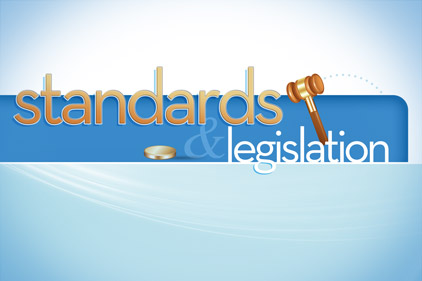The standards were established upon the passing of the Energy Independence and Security Act (EISA) in 2007.
Minimum Efficiency Standards
According to the standards set by EISA, manufacturers must equip each gas, oil, and electric hot water boiler, other than a boiler equipped with a tankless domestic water heating coil, with automatic means for adjusting the temperature for the water supplied by the boiler to ensure that an incremental change in inferred heat load produces a corresponding incremental change in the temperature of water supplied. Water or steam boilers will no longer be allowed to use standing pilots.
For a boiler that fires at one input rate, an automatic means that allows the burner or heating elements to fire only when the means has determined that the inferred heat load cannot be met by the residual heat of the water in the system.
The standards also state that, when there is no inferred heat load with respect to a hot water boiler, the automatic means described must limit the temperature of the water in the boiler to not more than 140˚F. The boiler must be operable only when the automatic means described above is installed.
Boilers that are manufactured to operate without any need for electricity or any electric connection, electric gauges, electric pumps, electric wires, or electric devices are not required to meet these rules.
Industry Impact
The U.S. Department of Energy (DOE) estimates that EISA-prescribed standards will save the U.S. approximately 31 quads of energy over 30 years.
Rich Simons, director of residential boiler controls, Honeywell Environmental & Combustion Controls, said he feels the standards change will have a very positive impact on the industry.
“Our industry is changing. No more standing pilot. Boilers will act a bit differently, and we all need training. But this is a good thing. We’ll also have opportunities to sell a more efficient product and to upsell even better efficiency. Good for our customers, good for our industry, and good for the environment,” said Simons.
“This will cause every boiler OEM to change control platforms and Honeywell, as a supplier, is engaged in supporting these activities. By transitioning to electronic platforms, the industry will be able to provide a more efficient product at installation with the ability to offer additional upgrades.”
Dave Bunnell, owner and president, The Steam Whisperer, Evergreen Park, Ill., said the efficiency change will provide minimal benefit for boiler contractors.
“This minor change in residential efficiency standards for hot water boilers will have little impact on overall energy usage for our nation over the current 20-year-old standards,” he said.
“It is forcing manufacturers to invest in a tiny gain in efficiency. The most common change in response to the increase in standards, eliminating standing pilot models from the product lines offered, is unlikely to see any true gains, as cast iron heat exchangers on pilot burning models stay much cleaner than those with pilots. The actual savings are likely to be even less than 2 percent. Changing to standards that measure real-world performance — energy used per square foot of a structure — not the efficiency of a piece of equipment, will put us on the right track.”
Defining Date of Manufacture
In January, the Air-Conditioning, Heating, and Refrigeration Institute (AHRI) submitted a written letter to DOE requesting specific clarification to the term “date of manufacture.” AHRI suggested that the date of manufacture be determined based on the date the primary heat exchanger is manufactured.
In March, DOE responded, stating: “If the dates the parts are completed and ready for distribution in commerce vary, the boiler is not ‘manufactured’ until the date the last component has been completed and is ready for distribution in commerce.”
DOE’s letter continued: “The manufacture date is determined by the date the product is off the production line and has been packaged for distribution. The manufacturer is responsible for certifying compliance of the complete boiler to DOE and for ensuring that the basic models meet the applicable standard when assembled in accordance with manufacturer instructions.”
DOE’s clarification essentially requires that all boiler components that will be noncompliant beginning Sept. 1 must be off the production line and packaged for distribution by that date. Products completed and shipped prior to Sept. 1 will not be impacted by new efficiency standards.
AHRI acknowledged the updated definition in an e-newsletter, dated March 2012, stating: “While DOE did not use AHRI’s exact definition, agency representatives agreed to this clarification of its current definition. This response will now be placed in the DOE online guidance database.”
Sidebar: Previous Standards
The National Appliance Energy Conservation Act of 1987 (NAECA) established the initial minimum-efficiency furnace and boiler standards. The standards, effective Jan. 1, 1992, required gas- and oil-fired furnaces perform at 78 percent AFUE; home furnaces, 75 percent; hot water boilers, 80 percent; and steam boilers, 75 percent.
In September 1993, DOE issued an advance notice of proposed rulemaking (ANOPR) that initiated a further standards rulemaking for furnaces and boilers. In fiscal year 1998, DOE assigned a low priority level to residential furnaces and boilers during its appliance rulemaking process, which limited its work on these products. However, in fiscal year 2001, DOE identified residential furnaces and boilers as priority products for an updated standards rulemaking.
In 2000, DOE initiated the process of updating the standards for residential furnaces and boilers. In July 2001, it held a framework workshop to discuss the process for analyzing new standards. In 2002, DOE met with stakeholders to discuss the manufacturing analysis and published a draft version of the engineering analytical tools. In May 2003, DOE organized a public meeting to receive and discuss comments on issues related to venting installations for residential furnaces and boilers, and to discuss research concerning venting systems. In July 2004, DOE published an ANOPR in the Federal Register and in October 2006, DOE published a NOPR. The standards were adopted by Congress in 2007.
Publication date: 6/4/2012



Report Abusive Comment